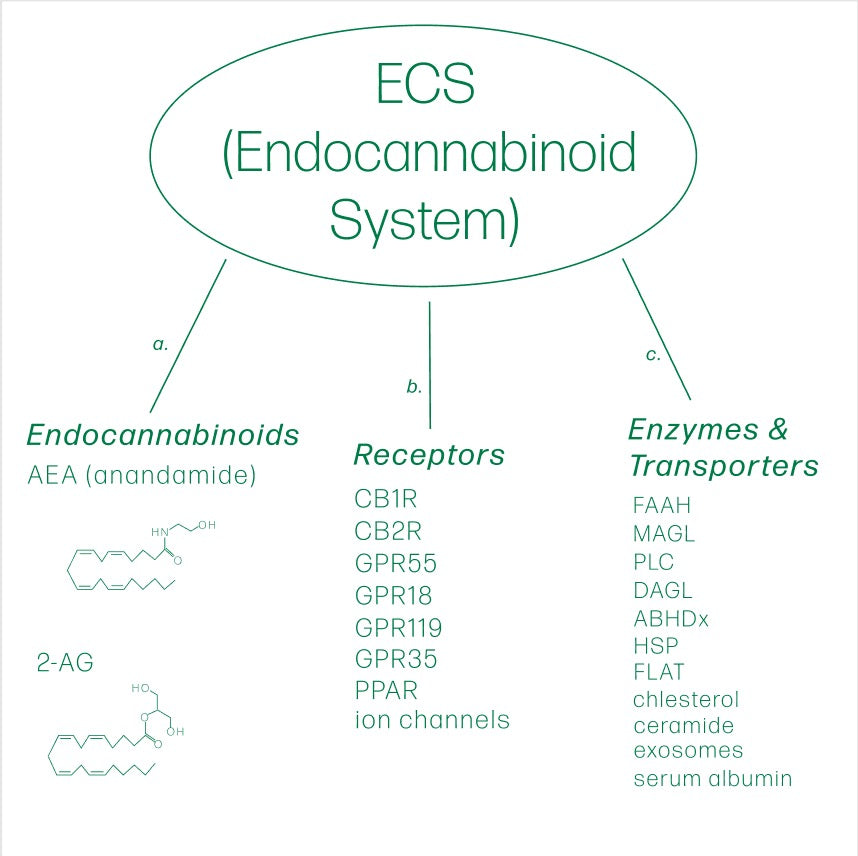[box]
Key Takeaways
- The endocannabinoid system is a biological system that maintains homeostasis (i.e. keeping our bodies in balance)
- The ECS is made up of receptors found throughout the body, which react to the presence of cannabinoids
- Our bodies naturally produce cannabinoids (referred to as endocannabinoids). In addition, phytocannabinoids (derived from a plant) also interact with the endocannabinoid system
- The endocannabinoid system is involved in a wide variety of processes, including pain, memory, mood, appetite, stress, sleep, metabolism, immune function, and reproductive function
[/box]
Intro
The cannabis plant, including the Hemp variety, has a wide range of potential therapeutic applications. Over the past few decades, scientists have begun to discover the underlying biological system responsible for these effects - this system is called the endocannabinoid system (or ECS for short).
In this article, we breakdown the basics of the endocannabinoid system (referred to as the ECS).
- What is the ECS?
- What are the components to the ECS?
- How do Hemp products interact with the ECS?
1) What is the ECS?
For decades after the identification of THC and other cannabinoids in the cannabis plant, scientists hypothesized that cannabinoids interact with an undiscovered system of the human body.
In 1990, a molecular biologist, named Lisa Matsuda, working in the laboratory of Tom Bonner at the National Institute of Health, discovered a receptor and proved that cannabinoids interacted with this receptor. She published her discovery in the scientific journal, Nature (https://pubmed.ncbi.nlm.nih.gov/2165569/), kicking off a new world of research on the endocannabinoid system. This receptor was named “cannabinoid receptor 1”, which is often referred to as CB1 or CBR1.
This discovery was just the tip of the iceberg. Scientists hypothesized that humans may produce endogenous cannabinoids that interact with these receptors. 2 years after the discovery of the CB1 receptor, Raphael Machoulem, W.A. Devane, and Lumir Hanus discovered the first endogenous cannabinoid, and named it Anandamine.
A year later, CB2, a second cannabinoid receptor, was identified. A year after that, another endogenous cannabinoid was discovered.
This system is called the Endocannabinoid System (referred to as the ECS). The ECS is named after the cannabis plant, as the system was discovered due to cannabinoids unique interactions with this system. The system is present throughout the human body, and plays a major role in maintaining homeostasis i.e. keeping our bodies in balance.
2) What are the components of the ECS?
The endocannabinoid system is a critical physiological system of the human body. But unlike most systems of the body which are clearly confined to certain organs or functions, the ECS is found in many different places. You can think of it as the "wifi" of the body, found in many different areas, managing communications and helping to keep the body in balance via its main 3 main components: receptors, cannabinoids, and enzymes.
As mentioned above, receptors are found throughout the body. Cannabinoids, which are naturally produced by our bodies, interact with these receptors, which in turn help to regulate bodily functions related to stress, sleep, temperature, etc.
Enzymes are the last component of the ECS. They are responsible for producing and breaking down cannabinoids in the body.
3) How do Hemp products interact with the ECS?
Hemp (and the broader cannabis plant) contains compounds called phytocannabinoids, including CBD, THC, CBG, CBC, and many more. When consumed, these compounds interact with our endogenous cannabinoid receptors. As such, we can naturally modulate our endocannabinoid system through the use of phytocannabinoids.
Given the prevalence of endocannabinoid receptors throughout the body, phytocannabinoid interaction with the ECS impacts the regulation of many physiological processes, including pain, memory, mood, appetite, stress, sleep, metabolism, immune function, and reproductive function.
To the future
The endocannabinoid system is a major breakthrough, and one that we believe will lead to significant positive impact in the next decades to come. However, we’re still in the early days of research on this system given its nascency and the barriers to research cannabis. We’re excited to follow and contribute to the discovery of the endocannabinoid system.
----
Have questions? We'd love to hear from you!
Reach me at sarabeth@bacehealth.com
----
Sources
De Laurentiis A, Araujo HA, Rettori V. Role of the endocannabinoid system in the neuroendocrine responses to inflammation. Curr Pharm Des. 2014;20(29):4697-4706.
McPartland JM, Matias I, Di Marzo V, Glass M. Evolutionary origins of the endocannabinoid system. Gene. 2006;370:64-74.doi:https://doi.org/10.1016/j.gene.2005.11.004.
Mackie K. Cannabinoid receptors: where they are and what they do. J Neuroendocrinol. 2008;20 Suppl 1:10-14. doi:10.1111/j.1365-2826.2008.01671.x.
Alger BE. Getting High on the Endocannabinoid System. Cerebrum Dana Forum Brain Sci. 2013;2013.
Maccarrone M, Bab I, Bíró T, et al. Endocannabinoid signaling at the periphery: 50 years after THC. Trends Pharmacol Sci. 2015;36(5):277-296.doi:10.1016/j.tips.2015.02.008.
Hanus. Lumir. O. (2007). Discovery and Isolation of Anandamide and Other Endocannabinoids. Chemisty and Biochemistry. Vol. 4. Pages 1828-1841.
Lee, Martin. A. (2012). Smoke Signals - A Social History of Marijuana Medical, Recreational and Scientific. New York, New York: Scribner.
Pertwee. Roger. G. (2006). Cannabinoid Phamacology: the first 66 years. British Journal of Pharmacology. Vol. 147. Pages 163-171.






